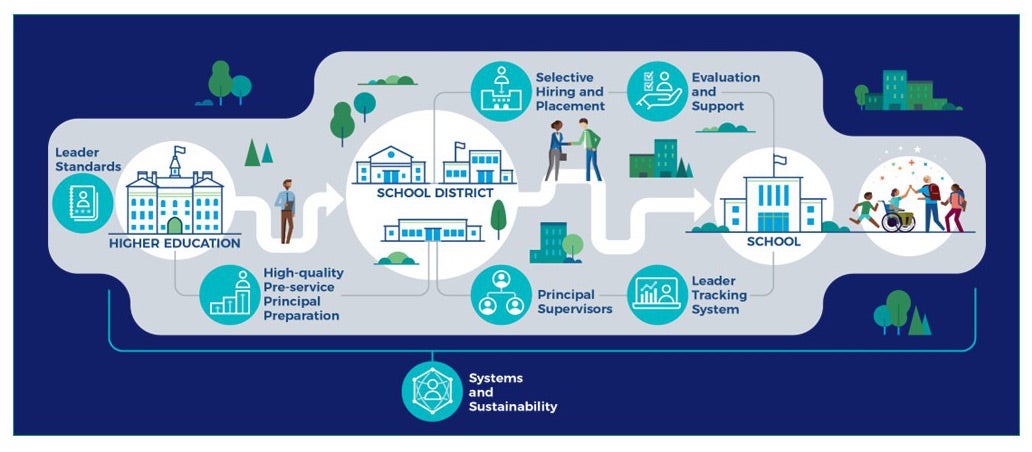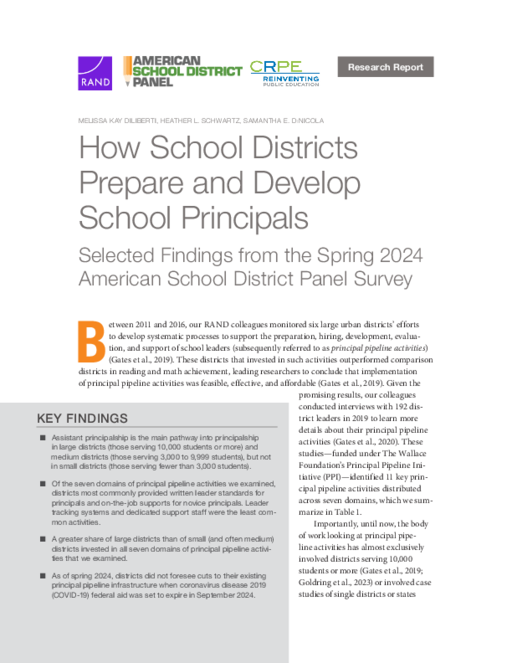Breadcrumb
- Wallace
- Reports
- How School Districts Prepare And...
How School Districts Prepare and Develop Principals
Selected Findings from the Spring 2024 American School District Panel Survey

- Author(s)
- Melissa Kay Diliberti, Heather L. Schwartz, and Samantha E. DiNicola
- Publisher(s)
- RAND Corporation
Summary
How we did this
In Spring 2024, the authors surveyed 156 American School District Panel member districts about principal pipeline activities to estimate the share of U.S. public school districts engaged in such activities. Researchers examined the activities by district enrollment size to investigate the hypothesis that the infrastructure to support the principal pipeline is primarily confined to large districts.
All principals are in some way prepared and supported in their positions. But research finds that when the different parts of a principal pipeline are developed in comprehensive and aligned ways, the results for principal retention and student learning are enhanced.
Pipelines include components like leader standards, preparation programs, and on the job supports and evaluation (see the full list below). Developing them requires commitment, partnerships, and resources.
Are some districts better positioned to implement these pipeline activities than others?
This report shares findings from a Spring 2024 survey of member districts of the American School District Panel on how–and if–they are implementing principal pipeline activities.
The researchers found that key principal pipeline activities varied by district size. Below, we outline the findings for each of the seven domains of principal pipelines:
- Large districts were more likely than small districts to report having written leader standards for principals
- Large districts were more likely than small and medium districts to report engaging in principal preparation activities
- Large districts were more than twice as likely as small and medium districts to report using selective hiring and placement processes.
- Majorities of small, medium, and large districts reported engaging on-the-job support and evaluation of principals.
- Nearly three times as many large districts as small and medium districts employed a principal supervisor.
- More than twice as many large districts as small and medium districts reported having leader tracking systems.
- Roughly three times as many large districts as small and medium districts reported having staff dedicated to principal pipelines.
The researchers note that the likely reason for these discrepancies is that large districts simply have more principals to hire, train, and support than small districts. For example, a robust hiring data system may not be needed for a district comprising only three schools. However, the researchers also point out that some of the pipeline domains, such as preparation and on-the-job support and evaluation, are needed regardless of district size.
To better support small districts, the researchers suggest that school principal associations, principal preparation programs, and state departments of education provide samples of principal standards and a playbook for small central district offices to use to support principals.
The findings also show that large and medium districts reported the assistant principalship was the main pathway into principalship, but small districts did not. An additional key finding from the survey showed that districts overwhelmingly did not anticipate cuts to principal pipeline infrastructure due to the expiration of federal COVID-19 aid.

The simple fact that large districts have many school principals to prepare, screen, hire, place, and develop compared with smaller districts likely explains many of the large differences we see.
Key Takeaways
- Of the seven domains of principal pipeline activities, districts most commonly provided written leader standards for principals and on-the-job supports for novice principals. Leader tracking systems and dedicated support staff were the least common activities.
- A greater share of large districts than of small (and often medium) districts invested in all seven domains of principal pipeline activities.
- Assistant principalship is the main pathway into principalship in large districts (those serving 10,000 students or more) and medium districts (those serving 3,000 to 9,999 students), but not in small districts (those serving fewer than 3,000 students).
- As of spring 2024, districts did not foresee cuts to their existing principal pipeline infrastructure when COVID-19 federal aid expires.
Visualizations
Pipeline Infographic


